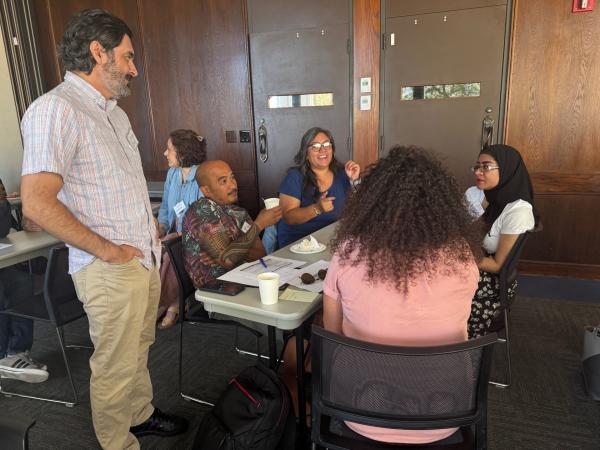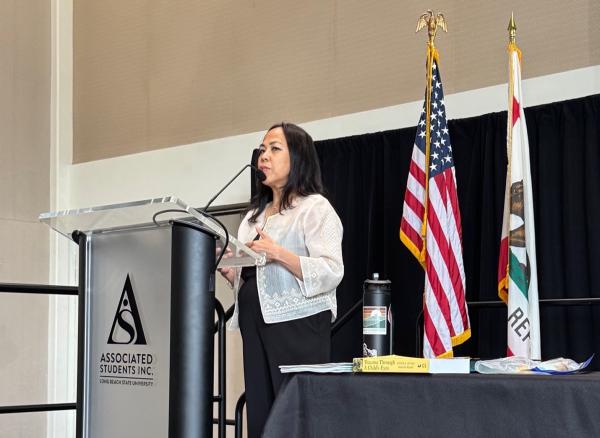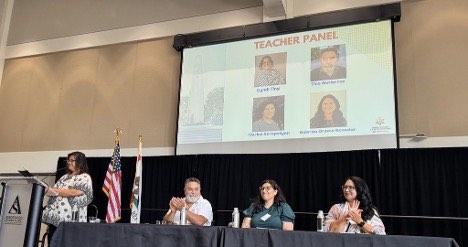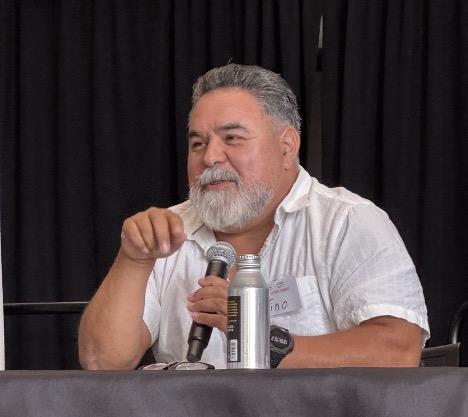Educators Summit centers care as foundation for learning
Teacher Jose Rivas was welcoming his students to class as he usually does, singing and playing his ukulele, when a student walked up to him looking dejected.
She’d used ChatGPT to do her homework the night before because she got out of work late and ran out of time. She’d gone to his office hours and still didn’t understand the assignment, she said, and no one at home could help her.
“I feel like I cheated and you’re going to give me a bad grade,” she told Rivas, who teaches at Lennox Math, Science and Technology Academy. “My parents are going to be so angry with me.”
Instead of punishing her, Rivas thanked her for her honesty. And he used it as an opportunity to discuss with his students ethical uses of artificial intelligence at school — by both them and him. They also created a code of ethics for the year.
“To implement AI ethically as a learning tool, we must build a strong sense of community with our students,” Rivas said this past Friday. “And having conversations with them along the way is vital to making AI work in our classrooms.”
Rivas, one of 10 teachers nationally selected for The Leading Edge AI in Education Fellowship this year, shared his story and advice at a breakout session during the 5th annual Center to Close the Opportunity Gap Educators Summit at Cal State Long Beach. The annual summit brings together local teachers, counselors, administrators and other educators to address some of the biggest issues in education today.
About 170 people attended this year’s summit in the University Student Union.

The topics of breakout sessions included ethical uses of AI, supporting neurodivergent students in traditional classrooms, teaching fractions, partnering with paraeducators, and strategies for teaching science to multilingual learners.
The overarching theme was “Rooted in Care: Taking care of our students, ourselves and each other.” Organizers chose it as a response to budget cuts and other political headwinds facing education today.
“One way to combat that is to make sure care is at the center of what we’re doing,” said Cara Richards-Tutor, co-director of the Center to Close the Opportunity Gap.
CCOG is a state-supported, multi-campus initiative that works with education partners to identify, refine and share strategies for improving academic success among PK-12 students in California.
The Math Science Teacher Initiative also supported the summit. SchoolsFirst Federal Credit Union sponsored its breakfast.
MORE ONLINE: Check out our photo gallery from the summit
In a powerful and deeply personal keynote speech, 2022 California Teacher of the Year Nichi Aviña described how childhood trauma affects students’ ability to learn, and how educators can become life-changing figures by helping them regulate their nervous systems.
Drawing from her own experience as a first-generation immigrant and trauma survivor, Aviña emphasized that adverse childhood experiences are not just painful memories—they are biologically embedded disruptions to a developing brain.

Aviña introduced strategies such as tracking, resourcing and grounding to help students — and educators — move from survival mode into a regulated “OK zone” where real learning and connection can happen.
Aviña guided the audience through mindfulness exercises, encouraged them to reflect on and share personal calming resources—such as a person, place, or object—and had them explore strategies for co-regulating with students during stressful or transitional moments.
Aviña credited her own survival and success to compassionate educators.
“Your presence and your ability to co-regulate with your students can literally save lives,” she said.
Her session concluded with a powerful call to action:
"Give yourself permission to live in your 'OK zone.' Chase the resilience. Teach your students how to live in their 'OK zone.' And when you do this, happiness happens."
A panel of teachers, meanwhile, explored the evolving meaning of self-care in the classroom — and why prioritizing personal well-being is essential for both educators and students.

Marine Karapetyan, who has been teaching in urban schools in Los Angeles and Long Beach for almost 15 years, said self-care was “nonexistent” when she started out. She devoted herself entirely to her students, working long hours at school and continuing to work at home.
Ironically, it was through pursuing a master’s degree that she learned how to better manage her time, prioritize meaningful tasks and say no to more minor, less-impactful obligations that drained her energy.
But then the COVID-19 pandemic brought new levels of exhaustion, Karapetyan said.
When an administrator suggested she just “log off” at 4 p.m., she was at first annoyed — someone had to develop the next day’s lesson. But then she took it to heart and realized she needed even firmer boundaries.
“One of the things I’ve learned is that if I don’t prioritize self-care, it’s not going to happen for me,” she said.
“And so I have to mentally remind myself: Does this benefit my mental health? Is this something that’s good for everyone, or am I hurting myself by saying yes to this?”
Veteran teacher Tino Gutierrez of El Rancho High School said he’s learned during 30 years in education that taking care of his body also helps him take care of his mind — and his students.

Whether it’s running hills, practicing yoga or just walking the campus at lunch, he said, small acts of physical care can sharpen focus and build resilience.
“There’s something about keeping the body healthy that helps the mind stay healthy — and that helps you teach better,” Gutierrez said.





